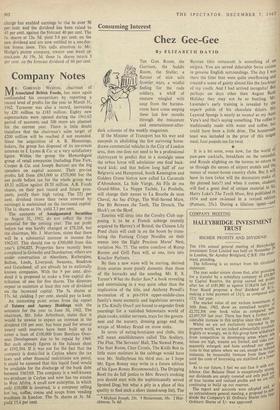Consuming Interest
Chez Gee-Gee
By ELIZABETH DAVID
If the Minister of Transport has his way and succeeds in abolishing the few surviving horse- drawn commercial vehicles in the City of London area, then one does not need to be a professional clairvoyant to predict that in a nostalgic sense the urban horse will administer one final back- ward kick; and that before long half of our Belgravia and Hampstead, South Kensington and Golders Green bistros now called La Casserole d'Abondance, La Sole Vierge, Au Fils de ma Grand-Mere, La Nappe Tachde, La Poubelle, will change their names to La Bouche de mon Cheval, Au Sac d'Orge, The Well-Served Mare, The Bit Between the Teeth, The Drench, The Hock's on the Hoof.
Tourists will stray into the Cavalry Club sup- posing it to be a French auberge recently acquired by Harvey's of Bristol; the Chinese Lily Pond chain will cash in on the boom by trans- lating the Fantang Crispy Noodles on their menus into the Eight Precious Mares' Nest, variation No. 75. The entire conclave of Rump Rooms and Grill Pans will, as one, turn into Knacker Parlours, By then a new wave will be starting, derived from sources more purely domestic than those of the barracks and the nosebag. Mr. E. S. Turner's What the Butler Saw,* a book revealing and entertaining in a way quite other than the implication of the title, and Anthony Powell's re-creation of a pre-1914 upper-middle-class family's more eccentric and lugubrious servants in The Kindly ()nest are bound to engender fresh yearnings for a vanished belowstairs world of plain cooks, soldier servants, trays for the govern- ness and the nursery, dressing gongs and the scrape of Monkey Brand on stone sinks.
In terms of eating-boutiques and clubs, this will mean establishments called The Scullery, The Flue, The Servants* Hall, The Stewed Prune, The Suet Room, Chez Cronin, The Knife Box (a little more moisture in the cabbage would have won Mr. Stalleybrass his third star, as I hope Mr. Egon Ronay may write in a future edition of his Egon Ronay Recommendst.), The Dripping Bowl (to do full justice to Mrs. Bravo's cooking you should start with the sophisticatedly served Spotted Dog; but what a pity in a place of this quality to find such a short tinned-soup list), The
* Michael Joseph, 25s, t Heinemann, 18s. t Hut- chinson, 7s. 6d.
Batman (this restaurant is something of an enigma. You are served delectable Swiss cuisine in genuine English surroundings. The day I was there the litter bins were quite overflowing and created a scene of gaiety almost like the faschings of my youth. And I had arrived incognito! But perhaps on days other than August Bank Holiday they may not be so bustling. Mr. Lavender's early training is revealed by the superb polish of his chocolate eclairs. His Layered Sponge is nearly as nuance as my Aunt Vera's and that's saying something. The coffee 15 traditionally made with water and coffee, but could have been a little drier. The homemade toast was included in the price of this soigne meal, four pounds ten for two).
It is a bit soon, even now, for the world of paw-paw cocktails, breakfasts on the verandah and Royals alighting on the tarmac to return to us through the names of airport motels and the, menus of manor-house country clubs. But it wilt have its turn (what will the decorators make of the plumed hats?) and when it comes, students will find a great deal of unique material in Sir. Harry Luke's The Tenth Muse, first published to 1954 and now re-issued in a revised edition (Putnam, 25s.). During a lifetime spent—and uncommonly well-spent, one deduces from this hook—in the Colonial Service, Sir Harry has collected recipes from British Residencies and Government Houses, from their chatelaines, their cooks—cooks Maltese and Cypriot, Hindu and Persian and Assyrian, cooks Goancse and Polynesian, cooks naval, military and consular, cooks in Union Clubs in South American capitals, cooks of French princes and Brazilian countesses, of Turkish Grand Viziers and Patriarchs of the Syrian Orthodox Church—and in setting down his recipes Sir Harry has acknow- ledged the source of each and every one : Govern- ment House, Springfield, St. Kitts; Government House, Fiji; St, Anton Palace, Malta; the Goanese cook at the Residency. Bahrein; Government House, Wellington. New Zealand; Count Haupt Pappenheim, Sao Paulo, Brazil; Lloyd, the butler at Kent House, Port of Spain. S11. Harry must be a gratifying guest. Every- thing interests him. The wife of the British Resi- dent in Brunei prefers to mix her own curry Powders, so off he goes with her to market, noting that she buys, separately and in varying quantities, black pepper, aniseed, cardamom, chillies, cinnamon, cloves, coriander, cumin, mace, nutmeg, poppyseed, saffron, tamarind, tur- meric... - As British Chief Commissioner in the Trans-Caucasian Republics of Georgia, Armenia and Azerbaijan, he attends a banquet (it is 1919) at Novo Bayazid; there he eats a Species of salmon trout unique to Lake Sevan and called ishkan, the prince; it is served 'sur- rounded by its own amber-coloured caviare, ac- c9111Panied by a sauce made of the cream of water-buffalo's milk, mixed with fresh peeled walnuts . . . with somewhere a touch of horse- radish . . the dish was subtly and incredibly delicious.' Delicious it sounds too; so does goose steeped in salt and sugar brine as it is done in the South Swedish province of Scania (recipe from the British Vice-Consul at Malmii); we get enticing information about how medlar and guava jellies to be served with meat and game are vastly improved by the inclusion of a little Worcester Sauce and fresh lemon juice in their composition; and how a lady who lives at Dramia, below the medixval castle of Butfa- vento in Cyprus, uses the leaf of the persica or wild cyclamen instead of vine leaves for her dishes of rice-stuffed dolmas.







































 Previous page
Previous page